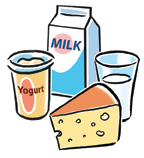Lactose Intolerance

Lactose is a simple sugar found in milk and dairy products. Lactose is found in dairy products, such as milk, cheese, cottage cheese, cream, sour cream, ice cream, sherbet, milk solids, powdered milk, and whey.
Lactose is digested with the help of an enzyme the body makes called lactase. People with lactose intolerance can't digest dairy products. This is because their bodies don't make enough lactase. Undigested lactose in the gut can't be absorbed. This can cause nausea, cramping, bloating, gas, diarrhea, and foul-smelling stools. These symptoms occur within 30 minutes to 2 hours after eating. Symptoms may be mild or severe.
Babies are born with the lactose enzyme, which allows them to absorb breastmilk. However, lactose intolerance may appear in children as early as 2 to 5 years old. Even if you have been able to eat dairy products all your life, your body may lose the ability to make the lactose enzyme as you get older. Asians, African Americans, Hispanics, and American Indians are prone to get this problem earlier in life.
Lactose intolerance is different from a milk allergy. A milk allergy is an immune system disorder.
Home care
These guidelines will help you care for yourself at home:
-
Your body doesn’t need dairy products to be healthy. So, if your symptoms are severe, it's best to stop eating dairy products that contain lactose.
-
If your symptoms are milder, you can probably do well consuming smaller amounts of dairy as long as you combine it with nondairy foods. Yogurt with live cultures may be OK because it contains enzymes that digest lactose. Butter, margarine, hard and aged cheeses (cheddar, Swiss) contain less lactose and may be OK to eat. You will have to experiment to learn how much dairy you can tolerate without getting symptoms. It may help to keep a food diary.
-
There are many lactose-free or low-lactose dairy products, including milk, ice cream, and cheeses, that allow you to still enjoy dairy products. You may also take a lactase enzyme as a supplement that will help you digest dairy products.
-
Everyone needs calcium and vitamin D in their diet for healthy bones. If you reduce or eliminate dairy from your diet, you need to replace it with other food sources that contain these nutrients, such as kale, broccoli, white beans, green beans, lima beans, salmon, soybeans, tofu, or fortified juices. Or, you can take daily supplements. Talk with your healthcare provider about your personal calcium and vitamin D needs. These can vary depending on age, gender, menopause status, and other things.
-
Learn to read food labels. Also watch for prepared foods that are made with products that contain lactose (such as bread, cereal, lunch meats, salad dressings, cake and cookie mix, and coffee creamers). Many people can have small amounts of lactose without symptoms. So an overly restrictive diet is often not needed.
-
Lactase enzyme supplements can be obtained over the counter. They can help control symptoms if you take the enzymes when you eat lactose.
Other products besides milk and milk products may contain lactose. They may be less obvious, so check the labels carefully. These things may not bother you, but should be considered if you continue to have problems:
-
Bread and other baked goods
-
Waffles, pancakes, biscuits, cookies, and mixes to make them
-
Processed breakfast foods, such as doughnuts, frozen waffles and pancakes, toaster pastries, and sweet rolls
-
Processed breakfast cereals
-
Instant potatoes, soups, and breakfast drinks
-
Potato chips, corn chips, and other processed snacks
-
Processed meats like bacon, sausage, hot dogs, and lunch meats
-
Margarine
-
Salad dressings
-
Liquid and powdered milk-based meal replacements
-
Protein powders and bars
-
Candies
-
Nondairy liquid and powdered coffee creamers
-
Nondairy whipped toppings
Follow-up care
Follow up with your healthcare provider, or as advised.
When to get medical advice
Call your healthcare provider right away if any of these occur:
-
Increasing belly (abdominal) pain or swelling
-
Abdominal pain that moves to the right side of the lower abdomen
-
Fever of 100.4ºF (38ºC) or higher, or as advised by your provider
-
Repeated vomiting or diarrhea
-
Blood in the stool or black and tarry stool (depending on the amount of blood, consider calling 911 for emergency help)